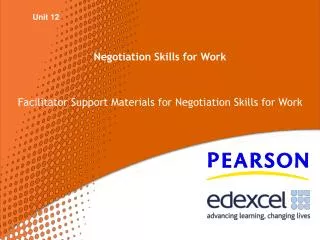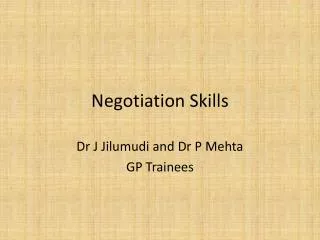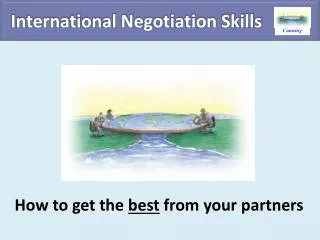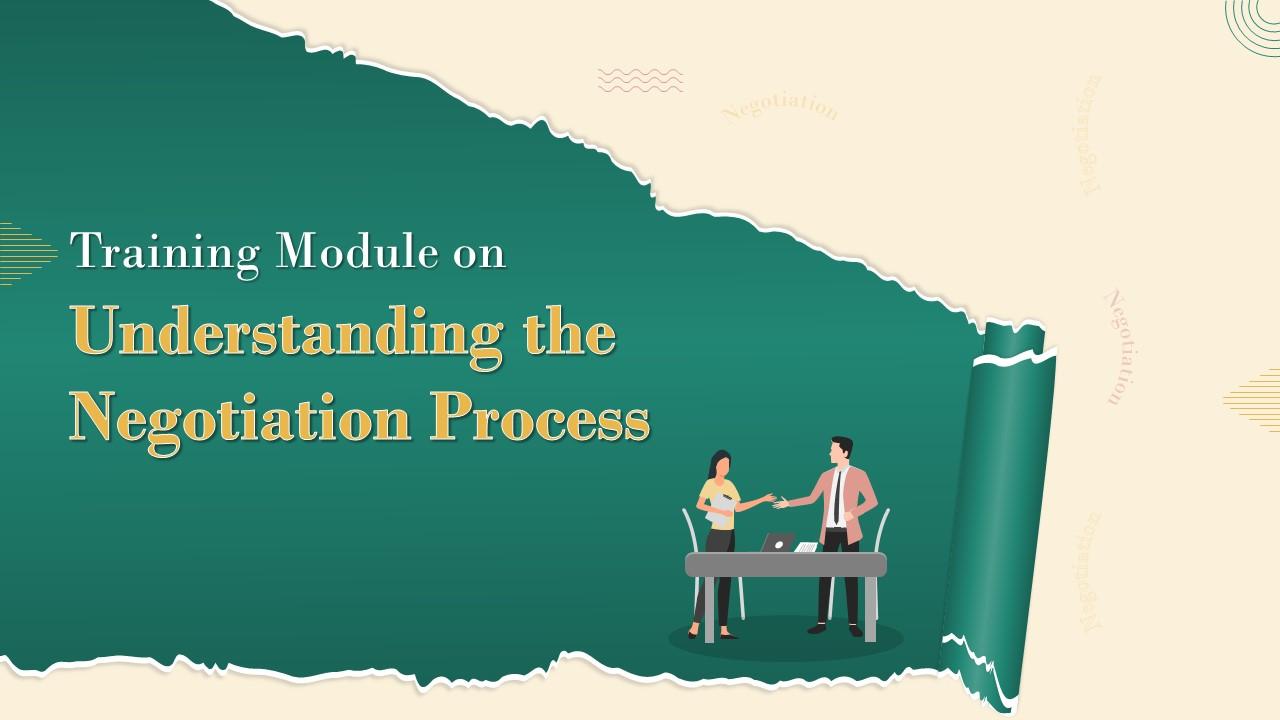

Negotiation Skills
Apr 03, 2019
6.16k likes | 11.67k Views
Negotiation Skills. Module One: Getting Started. Success in business requires training and discipline and hard work. But if you’re not frightened by these things, the opportunities are just as great today as they ever were. David Rockefeller. Welcome to the Negotiation Skills workshop.
Share Presentation
- usual negotiating approach
- effective negotiator
- information bargaining closing
- negotiation skills
- larger deposit

Presentation Transcript
Module One: Getting Started Success in business requires training and discipline and hard work. But if you’re not frightened by these things, the opportunities are just as great today as they ever were. David Rockefeller Welcome to the Negotiation Skills workshop. Although people often think of boardrooms, suits, and million dollar deals when they hear the word “negotiation,” the truth is that we negotiate all the time. For example, have you ever: Decided where to eat with a group of friends? Decided on chore assignments with your family? Asked your boss for a raise?
Workshop Objectives Apply strategies for identifying mutual gain Understand how to reach consensus and set the terms of agreement Deal with personal attacks and other difficult issues Use the negotiating process to solve everyday problems Negotiate on behalf of someone else • Understand the basic types of negotiations, the phases of negotiations, and the skills needed for successful negotiating • Understand and apply basic negotiating concepts: WATNA, BATNA, WAP, and ZOPA • Lay the groundwork for negotiation • Identify what information to share and what to keep to yourself • Understand basic bargaining techniques
Pre-Assignment Review • The purpose of the Pre-Assignment is to get you thinking about the negotiation process. • As a pre-assignment, think about what you consider the characteristics of a successful negotiator.
Module Two: Understanding Negotiation Information is a negotiator’s greatest weapon. Victor Kiam Before we get started, let’s take a look at two basic types of negotiation. We’ll consider the three phases of negotiation and the skills you need to become an effective negotiator.
Types of Negotiations • Integrative negotiations are based on cooperation. Both parties believe they can walk away with something they want without giving up something important. The dominant approach in integrative negotiations is problem solving. • Distributive negotiations involve a fixed pie. There is only so much to go around and each party wants as big a slice as possible. An example of a distributive negotiation is haggling over the price of a car with a car salesman. In this type of negotiation, the parties are less interested in forming a relationship or creating a positive impression.
The Three Phases Exchanging Information Bargaining Closing These phases describe the negotiation process itself. Before the process begins, both parties need to prepare for the negotiation.
Skills for Successful Negotiating • Self-confidence • Emotional intelligence • Persistence • Patience • Creativity • Effective speaking • Effective listening • A sense of humor • A positive attitude • Respect
Module Three: Getting Prepared If you don’t know where you are going, you will probably end up somewhere else. Lawrence J. Peter Like any challenging task, negotiation requires preparation. Before you begin a negotiation, you need to define what you hope to get out of it, what you will settle for, and what you consider unacceptable. You also need to prepare yourself personally. The key to personal preparation is to approach the negotiation with self-confidence and a positive attitude.
Establishing Your WATNA and BATNA • In most negotiations, the parties are influenced by their assumptions about what they think are the alternatives to a negotiated agreement. Often the parties have an unrealistic idea of what these alternatives are, and they are unwilling to make concessions because they think they can do just as well without negotiating. • WATNA (Worst Alternative to a Negotiated Agreement) • BATNA (Best Alternative to a Negotiated Agreement)
Identifying Your WAP • In any negotiation, it is important that you keep your WAP (Walk Away Price) to yourself, especially if it is significantly less than your initial offer. • If the other party knows that you will be willing to take a lot less than you are offering, then you will be negotiating from a position of weakness.
Identifying Your ZOPA • The ZOPA (Zone Of Possible Agreement) is the area in which the final price will sit, and within that ZOPA you will ideally end up with a price closer to their WAP than yours. • If you hint at where your WAP is, the other party will be less likely to come to an agreement that is substantially better than that.
Personal Preparation • As long as you understand your position, there is no danger that you will “lose” the negotiation. During and before negotiation you should always be: • Polite - It never reduces your argument • Firm - Removes Perceptions of Weakness • Calm - Facilitates Persuasion and Compromise • Do not take things personally
Module Four: Laying the Groundwork Everything comes to him who hustles while he waits. Thomas Edison In this module we consider other aspects of preparation: setting the time and place, establishing common ground, and creating a negotiating framework.
Setting the Time and Place • Environmental factors can interfere with • negotiations, for example: • A noisy setting • Frequent interruptions • Crowded conditions • Lack of privacy
Establishing Common Ground • Establishing common ground is a positive way to define the subject of a negotiation. • Once the two parties establish what they agree on, they will have a clearer idea of where they disagree. • The two parties use their shared interests to guide the negotiation.
Creating a Negotiation Framework • Both sides in a negotiation bring their own frame of reference based on their experience, values, and goals. • Before starting negotiations, it is essential to agree on which issues are up for negotiation and which are non-negotiable. • Without establishing a framework, negotiations can be extremely disorganized and lack direction.
The Negotiation Process
Module Five: Phase One — Exchanging Information The first step to getting the things you want out of life is this: Decide what you want. Ben Stein The first phase in a negotiation involves an exchange of information. Both sides state their positions on the issues being addressed in a non-confrontational way. The tricky part of this phase is deciding what to reveal and what to hold back.
Getting Off on the Right Foot • Getting off on the right foot involves creating an atmosphere of respect, setting a positive tone, and projecting an image of self confidence. • If you rush right into the negotiation without some initial pleasantries, the other party may feel that you are being pushy and aggressive.
What to Share • At the start of a negotiation, you don’t want to give a detailed statement about your position on specific issues. That is a subject for bargaining. • If the other party tries to rush you into stating your bargaining position prematurely, say something like, “That’s an important question. Before we get to that, let’s make sure we agree on the issues we’re discussing today.”
What to Keep to Yourself • You don’t want to appear secretive or deceptive, but at the same time you don’t want to give away your bargaining position prematurely. • Your success in negotiations depends on knowing what to say, when to say it and when to be silent.
Module Six: Phase Two — Bargaining My idea of an agreeable person is someone who agrees with me. Benjamin Disraeli Now we have reached the heart of the negotiation process. This phase — bargaining — is what most people mean when they talk about negotiation.
What to Expect • In addition to learning about the pressures, targets, and needs that might influence your opponents, you might also want to try to get some idea of their usual negotiating approach. • Do they typically start out with an unreasonable offer? • Do they try to rush the negotiation? • Do they try to frame the issues to their own advantage?
Techniques to Try Anticipate compromise. Offer and expect commitment. Don't absorb their problems. Stick to your principles. Close with confirmation. Prepare, prepare, prepare. Pay attention to timing. Leave behind your ego. Ramp up your listening skills. If you don't ask, you don't get.
How to Break an Impasse • If the impasse involves money, change the terms: a larger deposit, a shorter pay period, etc. • Change a team member or the team leader. • Agree on easy issues and save the more difficult issues for later. • Change the list of options being considered. • Agree to adjourn for a fixed period of time to try to come up with other options.
Module Seven: About Mutual Gain When dealing with people, remember you are not dealing with creatures of logic, but with creatures of emotion. Dale Carnegie In their classic book Getting to Yes, Roger Fisher and William Ury argue that most negotiations are not as efficient or as successful as they might be because people tend to argue about positions rather than interests. They suggest that the parties in a negotiation focus on their interests. What can we get out of the negotiation that will further our interests? That is the question that should guide a negotiation toward achieving mutual gain.
Three Ways to See Your Options • Positional Bargaining: Soft Participants want to be friends The goal is agreement • Positional Bargaining: Hard Participants are adversaries The goal is victory • Interest Bargaining Participants are problem solvers Participants invent options for mutual gain
About Mutual Gain • The key to making the mutual gain approach work is to focus on interests, not positions. • The answer in most situations may be a compromise. • This allows both parties to get something of what they want, without either side having to give up too much.
Creating a Mutual Gain Solution • Brainstorming to “expand the pie” by coming up with a range of options • Identifying shared values to help create options that will meet the interests of both parties • Changing the scope of the negotiation — making it larger or smaller • Identifying issues that can be set aside for future negotiations
What Do I Want? • To begin, identify what you personally want out • of the negotiation. Try to state this positively. • Examples: • I want a fair share of all new customers. • I want a better working relationship with my manager. • I want changes to the schedule.
What Do They Want? • These framing questions will help you start the • process. • What does my opponent need? • What does my opponent want? • What is most important to them? • What is least important to them?
What Do We Want? • Now that you have identified the wants and needs of both sides, look for areas of overlap. These will be the starting points for establishing mutual ground. • When working through the wants and needs of both parties, be careful not to jump to conclusions. Rather, be on the lookout for the root cause. Often, the problem is not what it seems.
Module Eight: Phase Three — Closing Negotiating in the classic sense assumes that parties are more anxious to agree than to disagree. Dean Acheson The final phase of a negotiation is a time for reaching consensus and building an agreement. A little hard work in this phase can ensure that the negotiation achieves it desired results.
Reaching Consensus • Have I reached an agreement that comes as close as possible to fulfilling my interest(s)? • Will other parties to the agreement fulfill their commitment? Do we have a good process for measuring and monitoring fulfillment by the parties? • Do I feel satisfied by the substance of the agreement and the process by which it was reached? • Would the other party/parties give the same answers to these questions?
Building an Agreement • Building an agreement takes a special skill — the ability to translate generalities into specifics. • Negotiators should realize that at this stage of the process the bargaining is over. They should try to create an agreement based on a fair and accurate interpretation of the consensus the parties have reached.
Setting the Terms of the Agreement • For an agreement to be successful, all the essential terms must be clearly stated in writing. • It is quite one thing to have an agreement in theory but it will be essentially meaningless without the practicalities. • The “how” is the most important of all, though, as without the firm details of how you are going to put everything in place you can agree whatever you want and it will not matter.
Module Nine: Dealing with Difficult Issues All things are difficult before they are easy. Thomas Fuller Most people are willing to negotiate in good faith. They don’t resort to tricks or intimidation. Every once in a while, though, you might encounter someone who takes a less principled approach.
Being Prepared for Environmental Tactics • Using environmental tactics to gain an advantage in a negotiation doesn’t happen that often, but negotiators need to be prepared for it. • One obvious case is the executive who refuses to come out from behind his desk and forces the other side to sit in visitors’ chairs. If this should happen, the best response might be, “I’m sorry, but I need some space to spread out my notes. Is there a conference room available?”
Dealing with Personal Attacks • There are a number of reasons why negotiators sometimes engage in personal attacks: • They may think that this type of behavior will give them an advantage in the negotiation. • They may see any disagreement with their position as a threat to their self-image. • They may feel that they are not being treated fairly or respectfully.
Controlling Your Emotions • Recognizing and controlling emotions is an aspect of “emotional intelligence.” • In a negotiation, emotional intelligence involves recognizing how you and the other party are responding emotionally to the discussion. • You will recognize when the emotional temperature is rising beyond where it should be, because discussions will become less focused, voices will be raised and the silences will be all the more silent.
Deciding When It’s Time to Walk Away • It’s time to walk away from a negotiation if: • The other party makes you feel threatened or extremely uncomfortable. • The other party uses unfair tactics that make it impossible to have an equitable negotiation.
Module Ten: Negotiating Outside the Boardroom Use soft words and hard arguments. English Proverb Negotiating isn’t just something that takes place in conference rooms with powerful forces aligned on either side of a table. People have informal negotiations every day — with their coworkers, merchants, even family members.
Adapting the Process for Smaller Negotiations • Separate the people from the problem. Don’t let personalities get in the way of negotiating. • Focus on interests, not positions. Consider what both parties want and need. • Expand the range of options. One way to overcome an impasse in a negotiation is to expand the range of the discussion. • State the terms of an agreement in specific, clear terms.
Negotiating via Telephone • Pay attention to particular points. • Listen Actively. Don't interrupt the other party; don't spend your 'listening time' figuring out how you're going to respond to them when they finally stop talking. The better you listen, the better you can learn, and the more likely you will be able to respond in a way that improves the negotiation's result. • Don't let the immediacy of a telephone call force you into fast, unwise decisions. There is nothing wrong with requesting more time to think about the terms discussed.
Negotiating via Email • It is appropriate to use email in a negotiation: • When the topic is clearly defined. • When the topic does not require extensive discussion • When the expected response is relatively simple • When there is little possibility of misunderstanding • It is not appropriate to use email: • When the topic is complex • When the topic requires extensive discussion • When the topic has great personal significance for the parties involved • When the topic is likely to stir up strong emotions
Module Eleven: Negotiating on Behalf of Someone Else To succeed as a team means to hold all of the members accountable for their expertise. Mitchell Caplan Negotiating on behalf of someone else presents some special challenges. When you begin such a negotiation, you need to have a clear idea of your Walk Away Price (WAP) and the concessions you have permission to make. You also need to be sure you understand the issues well enough to respond to tough questions that may come up in the negotiation.
Choosing the Negotiating Team • An essential part of leading a team of any kind is sharing information. Teams need information to thrive. Before the negotiation, hold a meeting with the team to make sure everyone has the information they need to make an effective contribution. You can also use these meetings to: • Remind everyone of the team’s goals • Ensure that everyone understands his or her role in the negotiation • Create a “game plan” for the negotiation
Covering All the Bases • Some negotiations are so complex that it is difficult for one person to master all the issues. • It is beneficial to have a team who feel that they can make decisions with an element of autonomy. This will allow them to operate naturally in a negotiation with little fear that they might overstep the mark.
Dealing with Tough Questions • Suggest (in a friendly way) that the question is irrelevant. For example, you might say, “I’m not sure how that question fits in here.” • Say you don’t know the answer. This is the best course of action to take if you really don’t know the answer. This approach is better than guessing. As a next step, you might say that you will find out the answer and get back to the questioner within a day or two. • Say that you would like to wait to respond to the question until later in the negotiation. This is the best thing to do if your answer will reveal too much about your position too soon. • Reply with a question of your own. This may help clarify the motivation of the questioner. (What is the questioner really asking?)
- More by User

Loan Negotiation skills
ARG helps the Americans in reducing their debt worries. It is important for every one to know how to negotiate. ARG provides tips on the importance of negotiation, things to do when you negotiate your debt.
925 views • 7 slides

PRACTICAL NEGOTIATION SKILLS
PRACTICAL NEGOTIATION SKILLS. by Jubeir Shamte Head of Commercial Management – Projects Wasl Asset Management Group. 30 th January 2012. What is negotiation?. Negotiation is a process of communication between two or more parties trying to reach an agreement. .
845 views • 14 slides

Negotiation Skills for Work
Unit 12. Negotiation Skills for Work . Facilitator Support Materials for Negotiation Skills for Work . Unit Aim.
498 views • 18 slides

Negotiation and Conciliation Skills
Negotiation and Conciliation Skills . Commissioner Jack Gregor WAIRC and AIRC Associate Professor Ray Fells Graduate School of Management, UWA. Concluding points first (!!). In preparation Be aware of what will happen if you keep saying “no”
389 views • 12 slides

Negotiation Skills. Dr J Jilumudi and Dr P Mehta GP Trainees . Objectives. Definition Styles Common mistakes. Definition. Negotiation involves two or more parties with competing or conflicting interests or needs, working towards an agreement on how they will cooperate Tillett, 1991
1.12k views • 49 slides

Negotiation Skills. Presented By: PAUL DAVIS . © Sigma Management Development Ltd 2004. Negotiating Techniques. IF you give me a bit of what I want THEN I can give you a bit of what you want Always trade values (£) Never trade a value without getting one in return.
973 views • 43 slides

Negotiation Skills. Presenter: Jennifer Kupec, CPCM, PMP®. Goals of Negotiation. Anticipated benefits which are greater than the sacrifice, a negotiated agreement should be beneficial Limit yielding so neither party believes that concessions would be more costly than the benefits of agreement
5.47k views • 53 slides

NEGOTIATION SKILLS
NEGOTIATION SKILLS. Business Management 12 Ms. Melbourne. What is negotiation?. Managers spend a great deal of time negotiating. Some examples: salaries for employees making deals working out differences with peers resolving conflicts with employees
664 views • 12 slides

Successful Negotiation Skills
Successful Negotiation Skills. Download the Original Presentation. Download the native PowerPoint slides, from my blog: http:// gdusil.wordpress.com/2013/04/25/successful-negotiation-skills / Or, check out other articles on my blog: http://gdusil.wordpress.com. Agenda. Definitions.
3.4k views • 26 slides

Negotiation Skills I
Introduction. Negotiation Skills I. Martin Weisser [email protected]. Outline. Introduction to the Course Possible Topics/Scenarios Defining Negotiation Identifying Requirements for Negotiation. Introduction to the Course. Aims: Identify Important Aspects of Negotiations
465 views • 10 slides

Negotiation Skills. Kalada Apiafi, ITF 099 (NIGERIA). OBJECTIVES. To Demonstrate The Concept Of Negotiation Identify The Role And Importance Of Power, Time, Information, Communication Skills And Personality In A Successful Negotiation
1.71k views • 37 slides

Negotiation Skills. Mahesh Sharma, MPA, ICMA-CM, MASCE City Administrator City of Raytown. Learning Objectives. Understand the purpose and importance of negotiation What are the different phases of negotiations Specific skills and techniques of negotiating
913 views • 27 slides

Negotiation Skills. “Getting to a ‘win’ for clients and for IMS” . Agenda. In the next two days, we will provide instruction and experience using negotiation in the IMS Sales process . Introductions and Course Objectives Current Pitfalls of Positional Bargaining IMS Principled Negotiation
1.93k views • 98 slides


Negotiation Skills… and the Negotiation Competition
Negotiation Skills… and the Negotiation Competition. Session 1/ Graham Robson. What happens. Law students in teams of two negotiate a dispute/ make a deal with another team. Teams get common facts explaining scenario Each team gets confidential info about their client. What happens.
453 views • 21 slides

Negotiation Skills Course
Negotiation Skills Course. Introduction. Introduction Training Norms Agenda Contents Negotiation-Outcomes Definition Positive- Behaviors Negative-Behaviors Successful Nego. Negotiation process Dos & DON’T’s. “You will never go beyond you dreams”. Training Norms. Introduction
596 views • 17 slides

Negotiation skills
Negotiation skills. Haiti Emergency Response Office Advocacy Team - April 2011. Negotiator’s Dictionary. Primary need: must be met or satisfied to achieve the outcome you need; Secondary need: should be met , but can be postponed/ delayed or compromised to meet your primary need;
946 views • 39 slides

Negotiation Skills. Presented By: RUSSELL CHESTERMAN . Negotiating Techniques. IF you give me a bit of what I want THEN I can give you a bit of what you want Always trade values (£) Never trade a value without getting one in return
740 views • 41 slides

International Negotiation Skills
International Negotiation Skills. How to get the best from your partners. Getting to a Deal. ?. US. THEM. Impose a solution Bully them Persuade them with logic Beat them with data Getting a Deal Sell the benefit Beg them/Appeal Bribe them Compromise
881 views • 45 slides

CLP Negotiation Skills
CLP Negotiation Skills. Getting what you want without losing the relationship. Objectives. Understand the key techniques for formulation of strong business relationships Prepare and plan negotiations in a structured and professional manner
791 views • 48 slides

Improve Your Negotiation Skills
Articulating the right requirements correctly to the other party help them to work on fulfilling the needs. If you are unable to alert them as to what you are aiming at, you will definitely not get it.
414 views • 20 slides

Negotiation SKILLS
Negotiation SKILLS. Suwarn Kumar Singh Sudip Tripathee. Session outline. Concept of negotiation 4 step frame work for negotiation Take away exercise. Negotiation. “Negotiation is about getting the best possible deal in the best possible way.”
673 views • 34 slides

NEGOTIATION SKILLS. A TRAINING SEMINAR FOR PARTICIPANTS IN THE DARE PROJECT, APRIL 2018, SOFIA, BULGARIA. DEFINITION. From Latin NEGOTIATUS – means CARRY ON BUSINESS NEGOTIATION PROCESS – interaction between people – usually direct and verbal interchange. What is negotiation?.
624 views • 13 slides
Newly Launched - World's Most Advanced AI Powered Platform to Generate Stunning Presentations that are Editable in PowerPoint

Powerpoint Templates
Icon Bundle
Kpi Dashboard
Professional
Business Plans
Swot Analysis
Gantt Chart
Business Proposal
Marketing Plan
Project Management
Business Case
Business Model
Cyber Security
Business PPT
Digital Marketing
Digital Transformation
Human Resources
Product Management
Artificial Intelligence
Company Profile
Acknowledgement PPT
PPT Presentation
Reports Brochures
One Page Pitch
Interview PPT
All Categories

Understanding The Negotiation Process Training Ppt
This training module on Understanding The Negotiation Process, in-depth covers the topics Positional Bargaining, Soft vs. Hard Negotiating, and Principled Negotiation. Further, it includes Stages of the Negotiation Process Prepare, Information Exchange, Clarify, Bargain, Problem-solve, Conclude and Implement and Barriers to Successful Negotiation Negative Outlook, Trying to with at All Costs Attitude, Strong Emotions, Lack of Empathy, Wrong Focus, and Blame Game. It also contains Key Takeaways and Discussion Questions related to the topic to make the coaching session more interactive. The deck has PPT slides on About Us, Vision, Mission, Goal, 30-60-90 Days Plan, Timeline, Roadmap, Training Completion Certificate, and Energizer Activities. It also includes a Client Proposal and Assessment Form for training evaluation.

- Add a user to your subscription for free
You must be logged in to download this presentation.
Do you want to remove this product from your favourites?
PowerPoint presentation slides
Presenting Training Deck on Understanding The Negotiation Process. This presentation deck contains 82 well-researched and uniquely designed slides. These slides are 100 percent made in PowerPoint and are compatible with all screen types and monitors. They also support Google Slides. Premium Customer Support available. Suitable for use by managers, employees, and organizations. These slides are easily customizable. You can edit the color, text, icon, and font size to suit your requirements.

People who downloaded this PowerPoint presentation also viewed the following :
- Business Slides , Complete Decks , All Decks , Training Modules , All Modules , Business Communication Skills , Negotiation , Negotiation
- Negotiation Strategies ,
- Sales Negotiation ,
- Vendor Negotiation ,
- Salary Negotiation ,
Content of this Powerpoint Presentation
This slide depicts information regarding positional bargaining. It highlights that positional bargaining is a negotiation strategy that entails holding on to a fixed idea, or position, of what a person wants and arguing for it and only it, regardless of any underlying interests. It also mentions that Positional bargaining can be classified into: Soft bargaining and Hard bargaining.
This slide depicts information about soft positional bargaining. It emphasizes the importance of developing relationships in soft positional bargaining, which leads to the parties taking a softer approach to the negotiation. This could lead to a win-lose situation in which they lose by giving up too much to maintain a good relationship.
This slide explains hard positional bargaining and emphasizes the importance of getting what you want during negotiation by playing hardball and being tough on the other person. It also mentions the characteristics of hard positional bargaining such as: Participants are adversaries, the goal is a victory as a condition of the relationship, demand concessions, and being harsh with both the problem and the people.
This slide illustrates information regarding principled negotiation. It highlights that principled negotiation is a method of resolving disputes between parties and is also known as a "win-win" situation. It focuses on improving everyone's interests and finding mutually beneficial solutions.
This slide depicts the rules of principled negotiation. The three rules are: Separate the person from the problem, focus on interests, not positions, and generate options for mutual gain.
Instructor’s Notes:
The Rules of Principled Negotiation are:
- Separate the person from the problem: It is possible to be gentle with the people you work with while being tough on the problem. One can act in ways that are respectful of the other and treat the other person well. This can be done even as you work hard on addressing the substantive issues that led to the negotiation in the first place
- Focus on interests, not positions: Creative solutions can be accomplished by focusing on the parties' mutually shared interests. Positions are statements about what someone wants or needs from a situation, whereas interest is the underlying reason or motivation for the position
- Invent options for mutual gain: It is critical to generate multiple options that may satisfy the interests of both parties. Brainstorming techniques, for example, can be used to create multiple options from which a resolution can be developed later
This slide illustrates the Five Stages of the Negotiation Process. The stages are: Prepare, Exchange information, Clarify, Bargain and Problem-solve, and Conclude & Implement.
The Five Stages of Negotiation Process are:
- Prepare: Negotiation preparation is easy to overlook, but it is a crucial first step. To prepare, research both sides of the debate, identify any potential trade-offs, and determine your preferred and least preferred outcomes. Then, make a list of the concessions you're willing to make on the bargaining table, determine the relationship you want to build or maintain with the other party, and prepare your BATNA (“Best Alternative to a Negotiated Agreement"). Preparation can also include establishing ground rules, such as where, when, with whom, and under what time constraints the negotiations will occur
- Exchange Information: This is the negotiation stage in which both parties exchange their initial positions. Each side should be free to express their underlying interests and concerns, including what they hope to achieve at the end of the negotiation and why they feel the way they do
- Clarify: In this step, both parties continue the discussion while exchanging information to justify and support their claims. If one side disagrees with something the other side is saying, they should discuss it calmly to reach an understanding
- Bargain and Problem-solve: This stage is the heart of the negotiation process, in which both parties begin a give-and-take. Following the initial offer, each negotiating party should make and manage their concessions while creating and managing counter-offers. Keep your emotions in check during the bargaining process; the best negotiators use strong verbal communication skills. This step aims to arrive at a win-win situation—a positive course of action
- Conclude and Implement: Once an acceptable solution has been reached, both parties should thank each other for the discussion. Successful negotiations are all about building and maintaining long-term relationships, and then they should outline each party's expectations and ensure that the compromise is implemented. This step is frequently accompanied by a written contract and a follow-up to ensure that the implementation is proceeding smoothly
This slide explains the first stage of negotiation process that is Preparation. It mentions that negotiation preparation is easy to overlook, but it is a crucial first step. It also highlights that preparation also include establishing ground rules, such as where, when, with whom, and under what time constraints the negotiations will occur.
This slide explains the second stage of negotiation process which is exchanging information. It highlights that exchanging information is stage of negotiation in which both parties exchange their initial positions.
This slide describes the third stage of negotiation process that is clarification. It highlights that in this stage, both parties continue the discussion while exchanging information by justifying and supporting their claims. At this stage if one side disagrees with something the other side is saying, they should discuss it calmly to reach an understanding.
This slide explains the fourth stage of negotiation process that is Bargaining and Problem-Solving. It mentions that this stage is the heart of the negotiation process, in which both parties have to give-and-take. It also highlights that emotions must be in check during the bargaining process. Here, the best negotiators use strong verbal communication skills. This step aims to arrive at a win-win situation.
This slide depicts the fifth stage of negotiation process that is conclusion and implementation. In this stage, once an acceptable solution has been reached, both parties should thank each other. This stage is frequently accompanied by a written contract and a follow-up to ensure that the implementation proceeds smoothly.
This slide explains how a negative attitude toward the negotiation process can be a roadblock to successful negotiation. It states that attitude determines the tone of the negotiation, which can be hostile or cooperative. It also emphasizes that negotiation does not have to be adversarial. Effective negotiation distinguishes itself by the parties working together to find a solution rather than each party attempting to defeat the other.
This slide explains a ‘Try to win at all costs’ attitude as a barrier to successful negotiation. It also mention that in negotiations, the best approach is to find a solution in which both parties 'win.' One must not think of negotiation as a competition that must be won.
This slide explains how strong emotions can hinder negotiation. It emphasizes how strong emotions cause us to lose sight of logic during negotiations. It also mentions that while it is natural to become emotional during a negotiation, we lose our ability to channel our negotiating behavior in constructive ways as we become more emotional.
This slide depicts a lack of empathy as a barrier to successful negotiation. It emphasizes that to find an acceptable solution for all parties, we must first understand the other party's needs and desires regarding the negotiation issue. It also mentions that a person will be unable to negotiate effectively if they do not know what the person requires or desires.
This slide explains how wrong focus is a barrier to a successful negotiation. It emphasizes that negotiators are more concerned with individuals than their issues, which is especially true of the people we dislike. It also highlights the importance of staying focused on the real problems and putting our personal feelings about the individual aside while negotiating.
This slide depicts blame game as a barrier to successful negotiation. It also highlights that playing the blame game complicates the negotiation situation. Each party contributes, for better or worse, to any conflict or negotiation.
Slide 36 to 51
These slides contain energizer activities to engage the audience of the training session.
Slide 52 to 79
These slides contain a training proposal covering what the company providing corporate training can accomplish for the client.
Slide 80 to 82
These slides include a training evaluation form for instructor, content and course assessment.
Understanding The Negotiation Process Training Ppt with all 87 slides:
Use our Understanding The Negotiation Process Training Ppt to effectively help you save your valuable time. They are readymade to fit into any presentation structure.

Ratings and Reviews
by Thomas Carter
February 17, 2023
by Chas Kelly
February 16, 2023


IMAGES
VIDEO
COMMENTS
a) A good negotiating relationship is needed to address differences and conflicts. b) Separate people issues from substantive issues. c) Plan and prepare to build and maintain a good working relationship. d) Be respectful, trustworthy and unconditional constructive.
Negotiation PowerPoint Slides include topics such as: basic components of negotiation, questions to ask, identifying the issues, assembling the facts, negotiation success strategies, techniques, and tactics, pros and cons of various negotiation approaches, 22 characteristics of effective negotiation, mediation, arbitration, maximizing your ...
ART OF NEGOTIATION SERIES #1: FUNDAMENTAL NEGOTIATION SKILLS. ITHS FACULTY CAREER DEVELOPMENT SERIES. SEPTEMBER 30, 2019. Jon Payne, Conflict Resolution Specialist, UW Medicine HR. LEARNING OBJECTIVES. 1. Review tools and strategies for improving the quality of our negotiation communications. 2.
The document outlines key aspects of negotiation including defining interests rather than positions, preparing by understanding goals, alternatives and the relationship, and focusing on integrative rather than distributive negotiations to find win-win solutions.
We’ll consider the three phases of negotiation and the skills you need to become an effective negotiator. Types of Negotiations • Integrative negotiations are based on cooperation. Both parties believe they can walk away with something they want without giving up something important.
This training module on Understanding The Negotiation Process, in-depth covers the topics Positional Bargaining, Soft vs. Hard Negotiating, and Principled Negotiation.